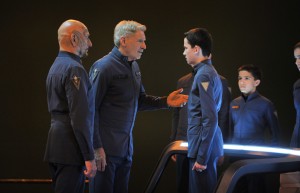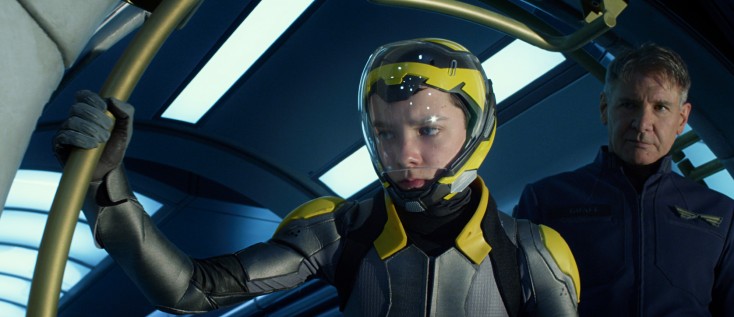
(L-R) BEN KINGSLEY, HARRISON FORD, ASA BUTTERFIELD and ARAMIS KNIGHT star in “ENDER’S GAME.” ©Summit Entertainment. CR: Richard Foreman.
By ANGELA DAWSON
Front Row Features
HOLLYWOOD—Whatever you do, don’t call Harrison Ford, the actor who embodied Han Solo and Indiana Jones, an icon.
“I don’t know what an icon does except stand in a corner quietly accepting everyone’s attention,” he says in his low, gravelly voice. “I like to work so there’s no utility in being an icon.”
Believe it or not, Ford is 71, an age when most guys have retired or at least slowed down. But Ford shows no sign of slowing, never mind taking a bow, and wrapping up his long and industrious acting career. He starred earlier this year in the baseball biopic “42,” winning rave reviews for his depiction of Baseball Hall of Famer Branch Rickey. His performance in that film, in which he broke the League’s color barrier by hiring African-American ballplayer Jackie Robinson to the Brooklyn Dodgers, has generated buzz that he may be up for an overdue second Oscar nomination. He previously was nominated for his leading role in 1986’s “Witness.”
His early onscreen performance as the maverick space pilot in the first “Star Wars” trilogy sent his career into the stratosphere. But since then, his roles have been decidedly more Earthbound.
So fanboys (and fangirls) have a lot to look forward to in seeing Ford back on a spacecraft for the first time since 1983’s “Return of the Jedi.”
In “Ender’s Game,” based on Orson Scott Card’s popular fantasy bestseller, he plays Colonel Hyrum Graff, a no-nonsense commander of an elite military school, where only the best and brightest youngsters are selected to train as warriors. The school is based on an orbiting space station where they compete for a chance to become commander of the International Forces. As Graff, Ford is a feared and respected leader. He discovers what could be the right candidate in a youngster named Ender (“Hugo’s” Asa Butterfield).
Graff deliberately alienates Ender from the other children in order to hone his individual leadership skills. His instincts have to be right as concerns rise of an alien attack by a race of insect-like creatures called Formics that already have shown their destructive power.
Impeccably dressed in a dark blue blazer, light blue shirt and slacks, Ford is stoic and no-nonsense as he discusses returning to the science-fiction genre after 30 years. He also reveals his thoughts on awards and, well, being an icon.
Q: Did you ever think you’d make another sci-fi movie?
Ford: It doesn’t matter to me if I go back to outer space or not, the job’s the same. I don’t have any genre preferences. I’m looking for good story, a good character, whether earthbound or not.
Q: You’ve had a great year playing Branch Rickey in “42,” and now this movie. And there’s an Oscar campaign being mounted for you for that earlier role. Would that award be important to you?
Ford: The campaign is largely an aid of trying to find a greater audience for the film. That would be a good thing. “42” is a wonderful movie and I’m very proud of the movie, and (about the Oscar campaign) what can you say?
Q: What did you think of Asa, who was only 15 at the time you worked together?
Ford: Asa has a kind of strength and capacity. Asa was cast before I was and (director Gavin Hood) was glad Asa had the strength to stand up against (me). That’s Gavin’s attempt to be flattering to me, more than anything else, but Asa is an amazing young person. He’s a very accomplished actor. He has wonderful focus, a capacity to focus and concentrate and has a wonderful work ethic. That combined with talent bodes well for his future.
Q: Since you last shot “Star Wars,” and effects-heavy space sequences, have there been any significant changes technologically that affect you as a performer?
Ford: Obviously, the techniques to create the visual elements have changed enormously. When we were making “Star Wars,” they were putting together space ships out of plastic model kits of cars and boats and trains, and gluing them all together and putting them on a stick and flying them past the camera. And it worked. It worked and it was fine. Add a little music and you believed that big spaceship coming over your head. The capacity to create effects in computer has made the job both easier but also has introduced the complexity with a few more keystrokes generate such a busy canvas that the eye doesn’t know where to go, you lose human scale on an event, and you’re just wowed by the kinetics and the visualization, but in some cases, you lose touch with the human characters and what it is that they would feel and how they might feel and I think that’s still the most important part. So you have to be very careful with effects that they don’t overpower the story with the visual element.
Q: Was it more fun flying around in the Millennium Falcon or commanding a space station?
Ford: I wasn’t in command of anything in “Enders Game.” I’m a trainer, responsible for the school and the young character Ender is orchestrating a battle that’s being fought remotely, as it were. For me, the fun of movies is always the collaboration, the work itself on the set, but I don’t know. “What’s more fun” questions—I don’t know how to (answer) them.
Q: Is it easy to find roles that still intrigue and engage you? And can you find something intriguing and engaging in the fifth part of the “Star Wars” series?
Ford: What I look for is identifying what the utility of a character is to the telling the story overall. If I can identify that from reading the script, then I have a clear idea whether or not the character is worth playing. Then the creation of that character—is it fully realized, is there more work to be done, can I think of an idea that would make it better—I just like the process of taking something written on a sheet of paper and giving it life and shape. I like the collaborative process of filmmaking, which is to say I love my work and will continue to look for things that have the potential of being engaging and successful. Whether it’s the first it’s been done or the fifth time it’s been done doesn’t matter. What I looked for in the “Indiana Jones” films is that we advance the notion of the character, the audience’s understanding of the character from each film to the other, in an ambitious way. So Indiana Jones’ father would appear (or) his long lost love (or) the son he never knew would appear—all of that made it more interesting to me. The potential to build on the audience’s knowledge of a character, you can take advantage of that if you’re ambitious.
Q: When you were 12, what kind of kid were you and what did you play with your friends?
Ford: I grew up in a city (Chicago) and instead of playing games about space we played cowboys and Indians. We played games that were built on imagination. We used to play Superman. Crazy stuff. We played characters we knew based on comic books. Kids will always have imagination. Right now their imagination is stimulated by electronic games, often. I have a 12 year old. I see all his friends. They play outside a lot and their parents limit the amount of time they can spend with video games or on their iPhones and things. Parenting is a huge responsibility. It was in my time, when I was growing up and it still continues to be that responsibility. This film is one of those opportunities to do some parenting and engage your kids with some of the issues that this film speaks to.
Q: Is this a role where you were able to use your iconic reputation to work for you? Are there other roles where you have to work your way around that?
Ford: Icon means nothing to me. I don’t understand what it means to anybody, actually. It seems like a word of convenience. It seems to attest to the huge success of certain kinds of movies that I did but there’s no personal utility in being an icon. I don’t know what an icon does except stand in a corner quietly accepting everyone’s attention. I like to work so there’s no utility in being an icon. I don’t think about it.
Q: “American Graffiti” was released 40 years ago. Was there something you learned from making that film that still applies to the way you work today?
Ford: I was at a fairly early stage in my career and I was learning everything. I was learning how to deal with the camera. I was learning how to deal with a director. I was learning how to think about story. All of those things are considerations still. I think I’m still learning and still interested in perfecting whatever talents I have and continuing to grow as an actor and continuing to be useful in telling a story.
Q: What advice can you give young actors?
Ford: I’m not prone to giving advice. What’s I think is important for a young person is to be figure out how to be useful and not be so concentrated on themselves but to see what with they can do for the collaboration of making movie what they can do to work. It’s also important not base your ambition on anybody’s else history but to figure out how best to use your own personality and understanding of yourself to help tell other people’s stories. So there are two things: work hard and figure out how to be useful and don’t try to imitate anybody else’s success. Figure out how to do it yourself with yourself.
Q: What was it like working with your adult co-stars?
Ford: It was a great pleasure. I have the utmost respect for Sir Ben Kingsley and Lady Davis. They’re both tremendous actors and I was delighted to have the opportunity to work with them. Sir Ben is hugely imaginative in the creation of his character. I had no idea what to expect from his version of Mazer Rackham. I thought it was really intriguing and useful in the telling of the story. And Viola is just a wonderful, visceral actor to work with so I enjoyed working with her also. I was very pleased to be able to work with both of them.
Q: Do you have a favorite film of yours?
Ford: No. I have five kids; I don’t have a favorite kid either.




